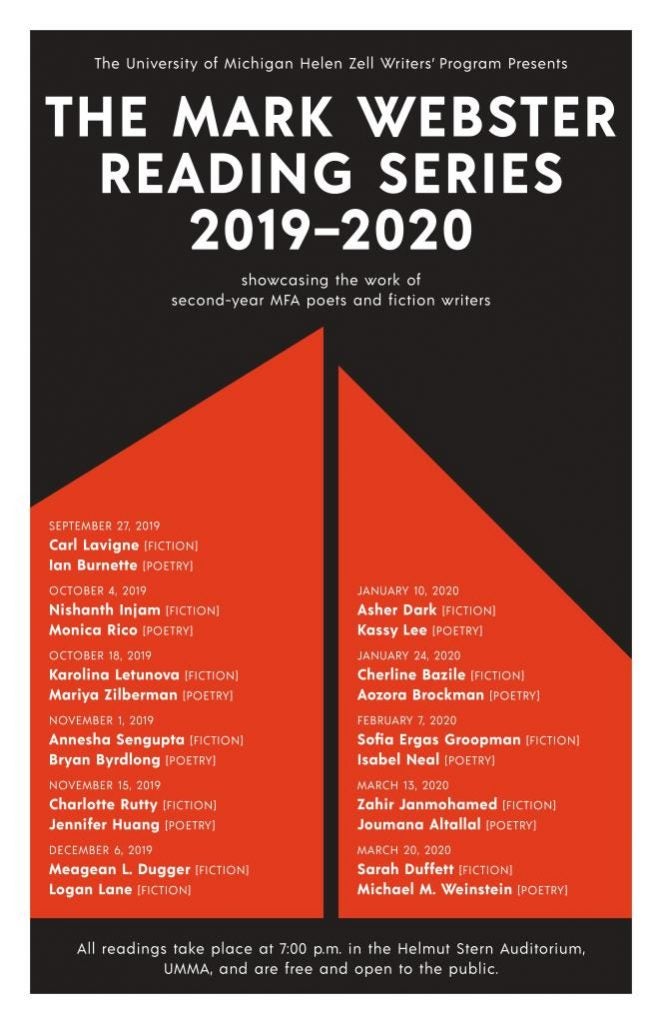Events and Important Dates:
Jane Kenyon Prize deadline: January 15th, 2020

Links to Online Poetry
Literary Forms (partial list)
- Sonnet: Definition Here or Hereor example: “Inside me is a black-eyed animal” by Terrence Hayes (bonus Shakespeare: Sonnet #130 )
- Pantoum: Definition Here or Hereor example: “Pantoum of the Great Depression” by Donald Justice
- Ghazel: Definition Here or Hereor example: “Ghazal for Becoming Your Own Country” by Angel Nafis
- Sestina: Definition Here or Hereor example: “Nani” by Alberto Ríos
- Villanelle: Definition Here or Hereor example: “One Art” by Elizabeth Bishop
- Abecedarian: Definition Hereor example: “Abecedarian Requiring Further Examination of Anglikan Seraphym Subjugation of a Wild Indian Rezervation” by Natalie Diaz
- Erasure: Definition Here or Hereor example: “Declaration” by Tracy K. Smith (erasure of the Declaration of Independence)

Craft Resources
Probably the most consistent method to think about craft is to read a wide variety of poetry. When you find poems that you like, look for techniques and rhythms the poet is utilizing.
There are a few craft books that tend to be consistently helpful resources for poets:
- A Glossary of Poetic Terms Edward Hirsch (some of these can be found at Poets.org)
- Rhyme’s Reason by John Hollander
- How Poems Get Made by James Longenbach
- The Sound of Listening: Poetry as Refuge and Resistance by Philip Metres
- Don’t Read Poetry: A Book About How to Read Poems by Stephanie Burt
- The Ecco Anthology of International Poetry edited by Ilya Kaminsky and Susan Harris
- Poems, Poets, Poetry by Helen Vendler
All of these books are available both at the Ann Arbor District Library and the University of Michigan Libraries.
Additionally, English 223 is the Introduction to Creative Writing class, open to all UM students and majors, and there are often other poetry class available each semester.
Through the Helen Zell Writers’ Program, the creative writing Master’s of Fine Arts at UM, there are visiting writers (link to the Zell Visiting Writers Series) each semester. These visiting writers generally have a “craft talk” or Q&A session in addition to a reading. Also through the HZWP, there are the Webster Readings (check poster below for dates) and the Edwards Readings where the MFA students read their work.
Locally, Literati has a monthly poetry reading group as well as a host of readings.


Writing Prompt
Find one place you frequent relatively often and write three attempts at recreating that image in a poem.
This “place” can be a bus bench, a memory of sitting with a friend in a snowy forest-scene, a bar, or a portion of the arb. The main restriction is that the “place” has to be recreated through through concrete and sensory details (smell, sight, taste, feel, or hear).
Try, first, to just write a literal account: what do you see, smell, hear, feel around you. In the second version, complicate that first account by looking for something you missed last time. In your third attempt, try to make the images symbolize something conceptual or emotional about the place you’re been recreating.
These need not be “complete drafts”—although I suggest working to polish the one version you thought was most interesting. Or else try merging the three versions into one poem.
**If there’s a resource or a writing prompt you think could be added to our lists, make your best argument and we’ll be happy to consider adding it. Please feel free to submit a contact us. **
